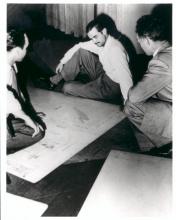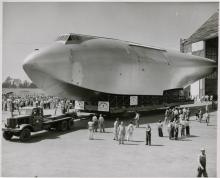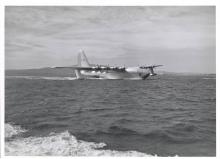Collection Paragraphs
The Flying Boat, a.k.a. the Spruce Goose

Hughes: These three pages... I feel do not give a clear or fair picture of the overall subject being covered here. In other words, if you found these quotes in my testimony [the 1947 Senate Hearings] then undoubtedly I testified in this manner, but this was a small part of a great deal of testimony and I think that here we have singled out a very weak portion of my testimony and used it to rebut some very strong statements by the opposition.
In other words my summary of this would be as follows: From the outset - now this is what I would call a fair statement in lieu of and in substitution for pages 200, 202 and 202 - From the outset the Army and the Air Corps and the Navy were opposed to this project because it had not originated through normal Army or Navy or Air Corps channels. It had originated through an appeal to the public made by Henry Kaiser. The Army, Navy, and Air Corps did not like projects to originate in this way...
The services liked to participate in the design of their product and I'm not going into argue the merit or demerit of this particular policy.

...now getting back to the Flying Boat. In this particular situation the Services were even more opposed to this project than they would have been had Douglas or Boeing, for example, designed and built an airplane on speculation without Air force participation. The Services were violently opposed to this airplane because they felt it had been pushed through by political pressure. It was not wanted by the Services. The Services considered it, in truth, a sort of slap or insult to their own efficiency up to that time. In other words this project was pushed through by Henry Kaiser on the basis that there was a crying need for it and why hadn't somebody built some cargo planes up to that time.
In other words, this thing was a black sheep. Nobody wanted to fool around with it or become contaminated by it and that probably accounts for the meager information. I don't believe anybody harried me for any reports to reveal progress or any of the rest of that. I just don't believe that occurred.
Now, I say, up to that time this airplane, and I think you will find this in my testimony, represented a lesser cost per pound to the taxpayers and a quicker delivery per pound than any... and consequently I think this represented a very, very cheap and very quick job.

Now in this particular airplane, however, the increase in size beyond the largest airplane ever designed or built prior thereto, was 3 times. In other words, I think this airplane was roughly 3 times larger than the largest airplane that had ever been built or designed thereto. Now this made such an enormous increment of increase that it carried us beyond the point on any available curves of known design criteria - beyond the point where extrapolation was possible. In other words, we were just way off the end of the paper and there was no way to take existing design information, design criteria, and extrapolate the curves a little ways beyond and say this is what ought to happen if it is this much bigger than the one before. This airplane was so much bigger than the one before, than anything that anybody had ever conceived up to that time, that we were working in a complete vacuum as to information based upon prior performance and prior design.
Now, furthermore, I may say that this airplane for the very first time in history reached into a size where manual control was utterly impossible, and this was just as important a barrier to cross as crossing the sonic barrier in speed.

Now in the case of this aircraft, the Hughes flying boat, the controls were so large, so much larger than any designed before, that for the first time we crossed into the area wherein it is absolutely impossible for any human being, whether he be Jack Dempsey or Joe Lewis rolled into one, it's utterly impossible for any human being to move the controls of this airplane - consequently it became necessary for the first time to design power control system which was as safe, let's say, as the structure of the airplane
So, although I may have admitted here that we could have done the airplane faster had we been less cautious and less careful in some respects, this was not intended to acknowledge that in any way the design or the manufacture of this airplane by standards of cost or time was in any way inferior to what it should have been. In fact, I say again, the facts show that it was a damn sight better than anyone could have expected.
Needless to say, I implore that this be deleted in its entirety. This would be an extremely unfair statement to make. The design of this airplane is not obsolete in any way. As a matter of fact, it is still way ahead of the power plants available... The design is not obsolete; in fact I defy anyone today to design an airplane substantially more efficient than this one for its purpose; namely the economical hauling of large heavy pieces of military equipment, such as tanks, field guns, artillery pieces, etc., over long distances.
